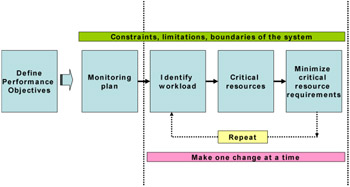1.5 Process of performance tuning
|
| < Day Day Up > |
|
1.5 Process of performance tuning
Develop a plan for performance monitoring and tuning by taking the inputs from the user, and recognizing the limits of tuning in your system.
Performance tuning is an iterative process. Depending upon the result of monitoring, adjust the configuration of the hardware, operating system, database server, and application server, and make changes to the applications that use this infrastructure. Base your performance monitoring and tuning decisions on your knowledge of the kinds of applications that use the data and the patterns of data access. Different kinds of applications have different performance requirements.
1.5.1 Developing a performance-improvement process
Choose performance criteria and set performance objectives based on those criteria. The main overall performance criteria of computer systems are response time and throughput.
Response time is the elapsed time between when a request is submitted and when the response from that request is returned. Examples include how long a database query takes, or how long it takes to echo characters to the terminal, or how long it takes to access a Web page.
Throughput is a measure of the amount of work over a period of time. In other words, it is the number of workload operations that can be accomplished per unit of time. Examples include database transactions per minute, kilobytes of a file transferred per second, kilobytes of a file read or written per second, or Web server hits per minute.

Figure 1-5: Performance tuning process
Performance tuning is primarily a matter of optimal resource management and correct system-parameter setting. Tuning the workload and the system for efficient resource use consists of the following steps:
-
Define performance objectives.
-
Determine how the results will be measured.
-
Quantify and prioritize the objectives.
-
-
Develop and execute a performance monitoring plan.
-
List the constraints, limitations, and boundaries of the system.
-
Identify the workloads on the system.
-
Identify the critical resources that limit the system's performance.
-
Minimize the workload's critical-resource requirements:
-
Use the most appropriate resource, if there is a choice.
-
Reduce the critical-resource requirements of individual programs or system functions.
-
Structure for parallel resource use.
-
-
Make one change at a time.
-
Repeat steps 4 through 7 until objectives are met or resources are saturated.
-
Apply additional resources, if necessary.
1.5.2 Performance-tuning limits
Every system has its own limitations and boundaries. Beyond certain limits you start releasing that even after putting a lot of efforts in tuning process only a small amount of efficiency benefits reaped from the system.
Try to consider how much time and money your management is ready to spend on improving system performance, and how much the end user will benefit from this process. Take care of budgets because sometimes significant performance improvement requires additional infrastructure, that is, you might need to add more disk storage, faster CPU, additional CPUs, more main memory, faster communication links, or a combination of these.
However, there is a point beyond which tuning cannot help. At this point, consider revising your goals and expectations within the limits of your environment.
|
| < Day Day Up > |
|
EAN: N/A
Pages: 90
- Key #1: Delight Your Customers with Speed and Quality
- Key #2: Improve Your Processes
- Making Improvements That Last: An Illustrated Guide to DMAIC and the Lean Six Sigma Toolkit
- The Experience of Making Improvements: What Its Like to Work on Lean Six Sigma Projects
- Six Things Managers Must Do: How to Support Lean Six Sigma